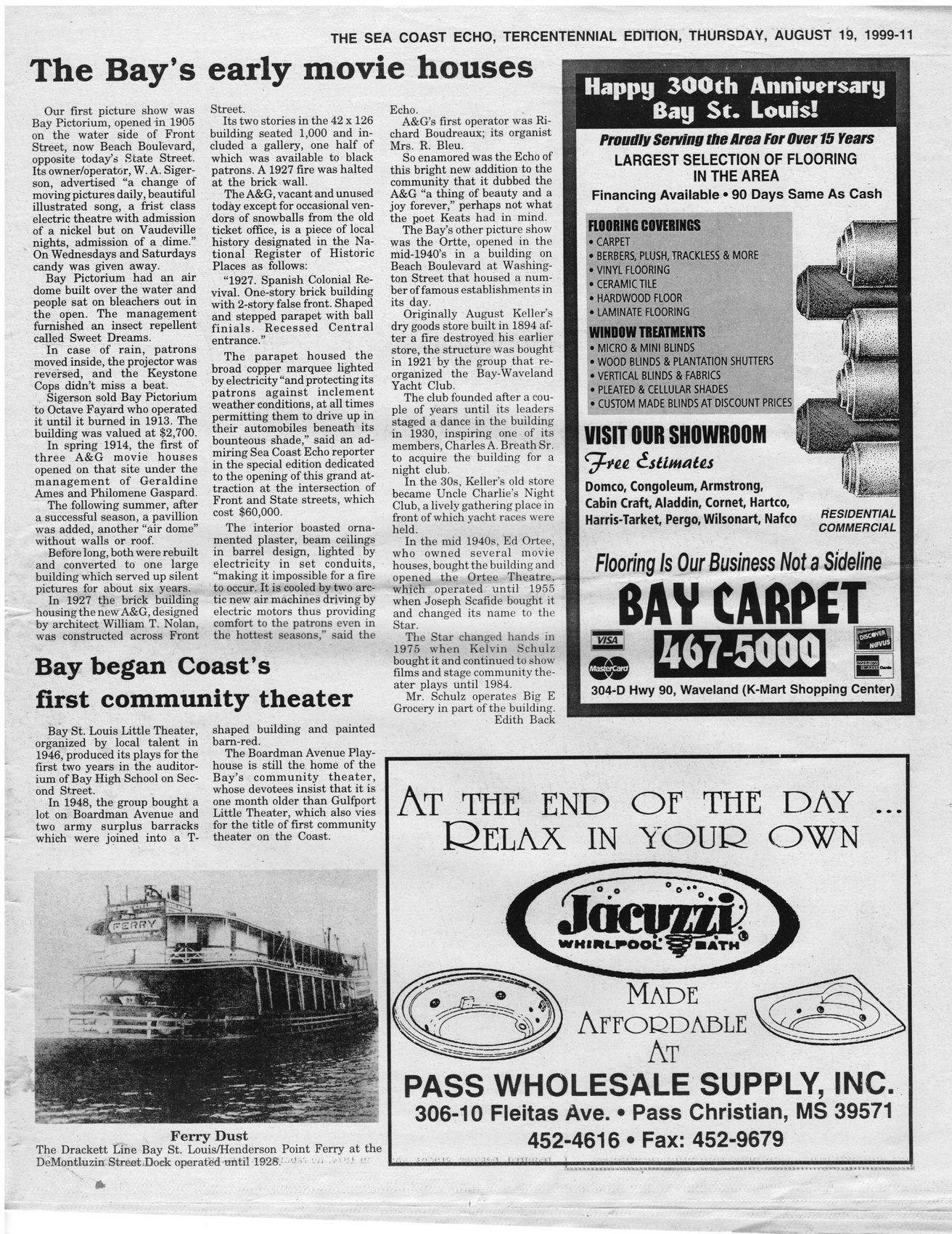This text was obtained via automated optical character recognition.
It has not been edited and may therefore contain several errors.
THE SEA COAST ECHO, TERCENTENNIAL EDITION, THURSDAY, AUGUST 19, 1999-11 Happy 300th Anniversary Bay St. Louis! The Bay’s early movie houses Our first picture show was Bay Pictorium, opened in 1905 on the water side of Front Street, now Beach Boulevard, opposite today’s State Street. Its owner/operator, W. A. Siger-son, advertised “a change of moving pictures daily, beautiful illustrated song, a frist class electric theatre with admission of a nickel but on Vaudeville nights, admission of a dime.” On Wednesdays and Saturdays candy was given away. Bay Pictorium had an air dome built over the water and people sat on bleachers out in the open. The management furnished an insect repellent called Sweet Dreams. In case of rain, patrons moved inside, the projector was reversed, and the Keystone Cops didn’t miss a beat. Sigerson sold Bay Pictorium to Octave Fayard who operated it until it burned in 1913. The building was valued at $2,700. In spring 1914, the first of three A&G movie houses opened on that site under the management of Geraldine Ames and Philomene Gaspard. The following summer, after a successful season, a pavillion was added, another “air dome” without walls or roof. Before long, both were rebuilt and converted to one large building which served up silent pictures for about six years. In 1927 the brick building housing the new A&G, designed by architect William T. Nolan, was constructed across Front Street. Its two stories in the 42 x 126 building seated 1,000 and included a gallery, one half of which was available to black patrons. A 1927 fire was halted at the brick wall. The A&G, vacant and unused today except for occasional vendors of snowballs from the old ticket office, is a piece of local history designated in the National Register of Historic Places as follows: “1927. Spanish Colonial Revival. One-story brick building with 2-story false front. Shaped and stepped parapet with ball finials. Recessed Central entrance.” The parapet housed the broad copper marquee lighted by electricity “and protecting its patrons against inclement weather conditions, at all times permitting them to drive up in their automobiles beneath its bounteous shade,” said an admiring Sea Coast Echo reporter in the special edition dedicated to the opening of this grand attraction at the intersection of Front and State streets, which cost $60,000. The interior boasted ornamented plaster, beam ceilings in barrel design, lighted by electricity in set conduits, “making it impossible for a fire to occur. It is cooled by two arctic new air machines driving by electric motors thus providing comfort to the patrons even in the hottest seasons,” said the Bay began Coast’s first community theater Bay St. Louis Little Theater, organized by local talent in 1946, produced its plays for the first two years in the auditorium of Bay High School on Second Street. In 1948, the group bought a lot on Boardman Avenue and two army surplus barracks which were joined into a T- shaped building and painted barn-red. The Boardman Avenue Playhouse is still the home of the Bay’s community theater, whose devotees insist that it is one month older than Gulfport Little Theater, which also vies for the title of first community theater on the Coast. Echo. A&G’s first operator was Richard Boudreaux; its organist Mrs. R. Bleu. So enamored was the Echo of this bright new addition to the community that it dubbed the A&G “a thing of beauty and a joy forever,” perhaps not what the poet Keats had in mind. The Bay’s other picture show was the Ortte, opened in the mid-1940’s in a building on Beach Boulevard at Washington Street that housed a number of famous establishments in its day. Originally August Keller’s dry goods store built in 1894 after a fire destroyed his earlier store, the structure was bought in 1921 by the group that reorganized the Bay-Waveland Yacht Club. The club founded after a couple of years until its leaders staged a dance in the building in 1930, inspiring one of its members, Charles A. Breath Sr. to acquire the building for a night club. In the 30s, Keller’s old store became Uncle Charlie’s Night Club, a lively gathering place in front of which yacht races were held. In the mid 1940s, Ed Ortee, who owned several movie houses, bought the building and opened the Ortee Theatre, which operated until 1955 when Joseph Scafide bought it and changed its name to the Star. The Star changed hands in 1975 when Kelvin Schulz bought it and continued to show films and stage community theater plays until 1984. Mr. Schulz operates Big E Grocery in part of the building. Edith Back Proudly Serving the Area For Over 15 Years LARGEST SELECTION OF FLOORING IN THE AREA Financing Available • 90 Days Same As Cash H00RIN6 COVERINGS •CARPET • BERBERS, PIUSH, TRACKLESS & MORE • VINYL FLOORING •CERAMIC TILE • HARDWOOD FLOOR • LAMINATE FLOORING WINDOW TREATMENTS • MICRO & MIN! BLINDS • WOOD BLINDS & PLANTATION SHUTTERS • VERTICAL BLINDS & FABRICS • PLEATED & CELLULAR SHADES • CUSTOM MADE BLINDS AT DISCOUNT PRICES VISIT OUR SHOWROOM dsllMMtes Domco, Congoleum, Armstrong, Cabin Craft, Aladdin, Cornet, Hartco, Harris-Tarket, Pergo, Wilsonart, Nafco il-i 1 I *wmm RESIDENTIAL COMMERCIAL Flooring Is Our Business Not a Sideline BAY CARPET HE 467-5 304-D Hwy 90, Waveland (K-Mart Shopping Center) Ferry Dust The Drackett Line Bay St. Louis/Henderson Point Ferry at the DeMontluzin Street,Dock operated until 1928. At the end or the day Relax in youd own Made Affordable At PASS WHOLESALE SUPPLY, INC. 306-10 Fleitas Ave. • Pass Christian, MS 39571 452-4616 • Fax: 452-9679 <»«*«»*«« ♦

BSL 1699 To 1880 SCE-Tercentennial-Edition-1999-(11)